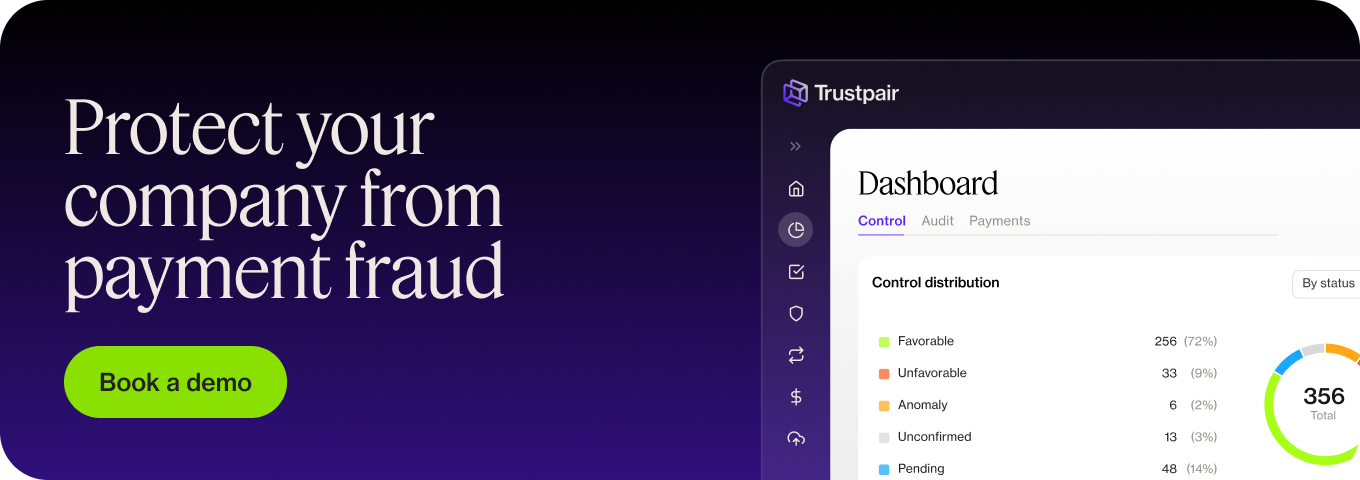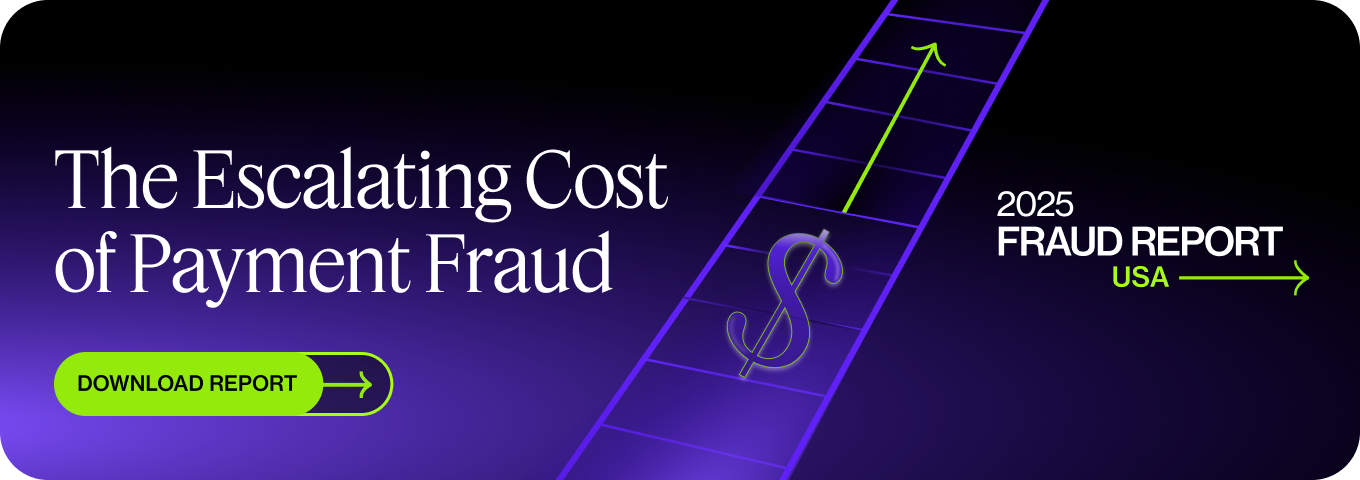56% of businesses were subject to fraudulent transactions in 2022. Interestingly, the same percentage of companies think this number will grow in the coming year. But the impacts of such cybercrimes hurt businesses deeply – casting a shadow of doubt over operations for years to come. So detecting these transactions, and fighting the overall risk of fraudsters, is the best way to protect your business.
Trustpair provides full control over payment campaigns, blocking fraudulently-operating criminals from accessing your funds before payment is ever made. Contact an expert to learn more!
What are the different types of fraudulent transactions?
Of course, there’s really no end to the types of fraud. However, we can group fraudulent b2b transactions into three major categories:
- Wire transfer fraud
- Vendor fraud
- Money laundering
But first, a definition.
B2B Fraudulent transactions, a definition
Fraudulent transactions refer to deliberately unauthorized purchases. In a b2b context, fraudulent transactions can be performed internally, by employees of your company, as well externally, by cybersecurity fraudsters.
Fraud victims of b2b transactions are often twofold, although this depends on the perpetrator and the way that the crime is committed. Of course, the business at the center of the transaction is the primary victim. But if a ‘third party’ fraud has been committed, in that the fraudster has impersonated someone else, this party also becomes a victim.
Wire transfer fraud
Wire transfer fraud happens most often through phishing. Typically, the fraudster will find your business email address and send an email with malware (disguised as a payment link).
By clicking on the link, you’ll inadvertently download the malware onto your computer and relinquish control to the cyber criminals. They can then wire money to themselves or choose to hold your system to ransom, forcing you to make the payment knowingly instead.
Vendor fraud
Vendor fraud describes the impersonation of one of your suppliers or merchants. Fraudsters perpetrate fraudulent transactions from your business to their accounts by committing identity theft. They impersonate a real supplier, and send a request to change the bank details or submit a new invoice. It’s a real issue – 55% of successful fraud attempts are perpetrated this way. Learn more on vendor fraud and how to prevent it here.
Sade Telecom, unfortunately, suffered from this exact fraudulent b2b transaction scam. It took three weeks before the team realized their ‘change of payment details’ request was from a false impersonator. The team has since partnered with Trustpair to prevent suffering from merchant fraud, or any other type of payment fraud, again.
Money laundering
Money laundering is the masking of earnings generated by criminal means in order to look legitimate. In a b2b setting, money laundering most often occurs internally – through senior leadership skimming funds from the finances and changing financial reports to fit.
The CEO of Reynolds & Reynolds committed money laundering in order to evade paying taxes over a period of multiple decades. Without proper internal controls, many businesses are vulnerable to internal fraudulent transactions through money laundering.
Learn more about B2B fraud and how to protect your company against it in our latest report.
How can you protect yourself from fraudulent transactions in business?
One of the main reasons that companies go wrong when trying to protect their businesses against fraudulent b2b transactions is by simply pretending that fraudsters don’t exist. Instead, by acknowledging that the threat of fraud is out there, you can build specific company controls to prevent and defend against the risk of fraud.
Training and Education
The first step to building out any good anti-fraud program is by involving your employees. Training sessions should be held regularly (at least once per quarter) in order to fully benefit your teams – by keeping the threat of fraud fresh in their minds.
Moreover, fraud awareness education encourages your people to stay up-to-date with the latest patterns in fraudulent transactions.
For example, a key emerging trend during the pandemic was the “gift card scam”. This form of business email compromise (BEC) encouraged employees to purchase gift cards on behalf of their company or colleagues. Then, the specific voucher codes were requested by the scammers and the money was wiped straight from gift cards in a quick fraudulent transaction.
Segregation of duties
The segregation of duties refers to the separation of different functions in finance between employees. For example, one colleague could create financial reports and another could double-check their accuracy.
Also known as the 4 eyes principle, it means no team member’s work goes unchecked and attempts of internal fraud are less likely to be successful.
The segregation of duties is also beneficial in the prevention of fraudulent B2B transactions since it provides an extra pair of eyes against external requests. For example, your payment approval process may require two co-signers before the payment is made. This is an extra layer of fraud protection against those who impersonate your suppliers, for example.
Strong internal control policies
Internal controls should be part of every process within your organization. They help with general quality control in your operations and provide a standard operating procedure when responding to all types of threats. Internal controls can be broken into preventative, detective, and responsive policies.
Strong internal audits are one example of a detective policy. This enforces good record-keeping since auditors need to access and analyze financial statements in order to spot suspicious patterns. Moreover, audits are often a legal obligation. They reveal mismatched information and help to hold team members accountable for their actions – further reducing the risk of fraud.
Data management policies
Data management policies are now required by law, with regulations like GDPR and the Colorado Consumer Privacy Act (CCPA). They specify how to collect and secure third-party data. However, a little-known benefit to personal information policies is that they can actually protect your business against fraud, too.
How?
Data management policies effectively fight fraudulent b2b transactions because they outline how you must protect data. It’s now much harder for hackers to access this protected info.
Moreover, data management policies now require changes to personal data to be tracked. It means that insiders are held accountable for changes made to customer or supplier information, making fraud detection easier.
Use fraud prevention software
Fraud prevention software is definitively the most effective measure for companies focused on fighting fraud. Choosing the best fraud prevention solution for your business, however, is not quite so simple.
When assessing different fraud prevention software, consider the likes of:
- Geographic coverage
- Real-time data
- Possible system integrations
- Pricing
- Security features
Let’s use Trustpair’s anti-fraud platform as an example. We help businesses protect against b2b payment fraud transactions specifically. This is primarily performed through the authentication of supplier data and constant monitoring of financial data for fraud reporting. Our advanced algorithm identifies suspicious activity that doesn’t fit with standard patterns and automatically blocks payments, protecting your company.
What can you do once a fraudulent transaction has been committed?
Responding to fraudulent transactions is not an exact science, but there are best practices to follow. These should give your business a fighting chance of getting your money back from scams, and prevent exposing further vulnerabilities in your payment systems.
Gather all relevant information
Admittedly, the first response after discovering fraud is often to panic. It’s understandable, but the sooner that you can gather the details about what happened, the better. You’ll need:
- The account number paid into / payment card number / social security number of the employee (if internal)
- The time and date of the crime
- Any indication of how it was pulled off (a screenshot of a scam email, for example)
This way, you can pass the information on to the right parties and attempt to regain the funds. Moreover, by assessing the situation immediately after discovering the fraud, you can prevent the thieves from coming back to try and cover up their crime.
Check your accounts regularly
Checking accounts regularly is a detection measure and can bring the fraud rate down. It ensures that your people are aware of the ‘normal’ behaviors and patterns and can spot suspicious anomalies when they occur. Plus, there is a risk that fraudsters commit multiple frauds at the same company. So checking regularly is important, even after fraud has been committed.
Automating these checks is a more reliable way to protect against fraud since it saves on manpower and can be performed overnight while employees are away from the office. Plus, you can get a distinct fraud alert each time anomalies are spotted.
Platforms like Trustpair facilitate the automatic checking of accounts with the 24/7 tracking of vendor data. This verifies that all details match up. We match financial, company and location data ensuring that they don’t appear on blacklists. As soon as any discrepancy is revealed, all payments to that supplier are blocked for the prevention of payment fraud.
Inform the authorities right away
Once a b2b fraudulent transaction is discovered, informing the authorities is key. While there is no guarantee that you’ll receive any lost funds back, it will start an investigation and hopefully produce fraudulent charges against the perpetrators. Your team members can then make changes to standard operating procedures in order to prevent fraud from happening a second time.
Right now, the US government is trying to encourage more information-sharing between federal bodies when they are infiltrated by fraudsters. This aims to help all companies fight against cybersecurity attacks. While Executive Order 14028 regulation doesn’t yet apply to private companies, it is a good idea to familiarize yourself with the requirements as they are likely to apply soon.
Consider tightening your security measures
In the wake of a fraud discovery at your workplace, it’s only natural to want to introduce new measures of protection. When tightening your security measures, consider the following strategies:
- Finance process digitization: automation of your key systems to prevent human interference
- System integration: by creating a flow of information from one of your platforms to another, you remove the risk of fraudulent activity and interception from internal or external fraudsters
- Securing your payments: instead of manual bank transfers or payment by check (where payment details have a high chance of being stolen), consider moving your b2b payments online to reduce fraud risks
To conclude…
Fraudulent b2b transactions are perpetuated through card fraud, wire transfer, vendor fraud and money laundering. Prevent your transactions from being compromised through fraud awareness training, internal controls, the segregation of duties and anti-fraud software. Don’t become a victim of fraud – demo Trustpair to tighten up your security measures.






